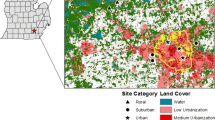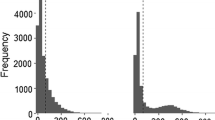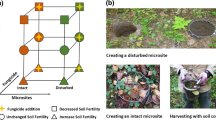Abstract
The roots of rain forest plants are frequently colonized by arbuscular mycorrhizal fungi (AMF) that can promote plant growth in the nutrient poor soils characteristic of these forests. However, recent studies suggest that both the occurrence of AMF on rain forest plants and the dependence of rain forest plants on AMF can be highly variable. We examined the occurrence and levels of AMF colonization of some common seedling species in a tropical and a subtropical rain forest site in Queensland, Australia. We also used a long-term database to compare the growth and mortality rates of seedling species that rarely formed AMF with those that regularly formed AMF. In both forests, more than one-third of the seedling species rarely formed AMF associations, while 40% of species consistently formed AMF in the tropical site compared to 27% in the subtropical site. Consistent patterns of AMF occurrence were observed among plant families at the two sites. Variation among seedling species in AMF occurrence or colonization was not associated with differences in seed mass among species, variation in seedling size and putative age within a species, or lack of AMF inoculum in the soil. Comparisons of four seedling species growing both in the shaded understory and in small canopy gaps revealed an increase in AMF colonization in two of the four species in gaps, suggesting that light limitation partially explains the low occurrence of AMF. Seedling survival was significantly positively associated with seed biomass but not with AMF colonization. Furthermore, seedling species that regularly formed AMF and those that did not had similar rates of growth and survival, suggesting that mycorrhizal and nonmycorrhizal strategies were equivalent in these forests. Furthermore, the high numbers of seedlings that lacked AMF and the overall low rate of seedling growth (the average seedling required 6 years to double its height) suggest that most seedlings did not receive significant indirect benefits from AMF through connection to canopy trees via a common mycorrhizal network.


Similar content being viewed by others
References
Alexander IJ (1989) Mycorrhizas in tropical forests. In: Proctor J (ed) Mineral nutrients in tropical forest and savanna ecosystems. Blackwell, Oxford, pp 169–188
Allen EB, Rincon E, Allen MF, Perez-Jimenez A, Huante P (1998) Disturbance and seasonal dynamics of mycorrhizae in tropical deciduous forest in Mexico. Biotropica 13:1701–1717
Allsop N, Stock D (1995) Relationship between seed reserves, seedling growth and mycorrhizal responses in 14 related shrubs (Rosidae) from a low nutrient environment. Funct Ecol 9:248–254
Bereau M, Garbaye J (1994) First observations on the root morphology and symbioses of 21 major tree species in the primary tropical rain forest of French Guyana. Ann Sci For 51:407–416
Bereau M, Louisanna E, Garbaye J (1997) Effects of endomycorrhizas and nematodes on the growth of seedlings of Dicorynia guianensis Amshoff, a tree species of the tropical rain forest in French Guyana. Ann Sci For 54:271–277
Bereau M, Barigah TS, Louisanna E, Garbaye J (2000) Effects of endomycorrhizal development and light regimes on the growth of Dicorynia guianensis Amshoff seedlings. Ann For Sci 57:725–733
Brundrett M, Bougher N, Dell BT, Grove T, Malajczuk N (1996) Working with mycorrhizas in forestry and agriculture. ACIAR Monograph 32, Canberra
Connell JH, Green PT (2000) Seedling dynamics over 32 years in a tropical rain forest tree. Ecology 81:568–584
Connell JH, Tracey JG, Webb LJ (1984) Compensatory recruitment, growth and mortality as factors maintaining rain forest tree diversity. Ecol Monogr 54:141–164
Connell JH, Debski I, Gehring CA, Goldwasser L, Green PT, Harms KE, Juniper P, Theimer TC (2005) Dynamics of seedling recruitment in an Australian tropical rainforest. In: Bermingham E, Dick CW, Moritz C (eds) Tropical rain forests: past, present and future. University of Chicago Press, Chicago, pp 486–506
Dickie IA, Koide RT, Steiner KC (2002) Influences of established trees on mycorrhizas, nutrition, and growth of Quercus rubra seedlings. Ecol Monogr 72:505–521
Foster SA (1986) On the adaptive value of large seeds for tropical moist forest trees: a review and synthesis. Bot Rev 52:260–299
Gehring CA (2003) Growth responses to arbuscular mycorrhizas by rain forest seedlings vary with light intensity and tree species. Plant Ecol 167:127–139
Gehring CA (2004) Seed reserves and light intensity affect the growth and mycorrhizal development of the seedlings of an Australian rain forest tree. J Trop Ecol 20:345–349
Gehring CA, Wolf JE, Theimer TC (2002) Terrestrial vertebrates promote arbuscular mycorrhizal fungal diversity and inoculum potential in a rain forest soil. Ecol Lett 5:540–548
Grubb PJ, Metcalfe DJ, Grubb EAA, Jones GD (1998) Nitrogen-richness and protection of seeds in Australian tropical rainforest: a test of plant defence theory. Oikos 82:467–482
Hopkins MS, Reddell P, Hewett RK, Graham AW (1996) Comparison of root and mycorrhizal characteristics in primary and secondary rainforest on a metamorphic soil in North Queensland, Australia. J Trop Ecol 12:871–885
Hyland BPM, Whiffin T (1993) Australian tropical rain forest trees: an interactive identification system. CSIRO, Melbourne, 564 pp
Janos DP (1980) Vesicular–arbuscular mycorrhizae affect lowland tropical rain forest plant growth. Ecology 61:151–162
Janos DP (1983) Tropical mycorrhizas, nutrient cycles and plant growth. In: Sutton S, Whitmore TC, Chadwick AC (eds) Tropical rain forest ecology and management. Blackwell, Oxford, UK, pp 327–345
Janos DP (1992) Heterogeneity and scale in tropical vesicular–arbuscular mycorrhiza formation. In: Read DJ, Lewis DH, Fitter AH, Alexander IJ (eds) Mycorrhizas in ecosystems. CAB International, Wallingford, UK, pp 276–282
Kennedy PG, Izzo AD, Bruns TD (2003) There is high potential for the formation of common mycorrhizal networks between understorey and canopy trees in a mixed evergreen forest. J Ecol 91:1071–1080
Lamont BB (1982) Mechanisms for enhancing nutrient uptake in plants with particular reference to mediterranean South Africa and Western Australia. Bot Rev 48:597–689
Lovelock CE, Miller R (2002) Heterogeneity in inoculum potential and effectiveness of arbuscular mycorrhizal fungi. Ecology 83:823–832
McGonigle TP, Miller MH, Evans DG, Fairchild GL, Swan JA (1990) A new method which gives an objective measure of colonization of roots by vesicular–arbuscular mycorrhizal fungi. New Phytol 115:495–501
Metcalfe DJ, Grubb PJ, Turner IM (1998) The ecology of very small-seeded shade tolerant trees and shrubs in lowland rain forest in Singapore. Plant Ecol 134:131–149
Onguene NA, Kuyper TW (2001) Mycorrhizal associations in the rain forest of South Cameroon. For Ecol Manag 140:277–287
Onguene NA, Kuyper TW (2002) Importance of the ectomycorrhizal network for seedling survival and ectomycorrhiza formation in rain forests of south Cameroon. Mycorrhiza 12:13–17
Osunkoya OO, Ash JE, Hopkins MS, Graham AW (1994) Influence of seed size and seedling ecological attributes on shade-tolerance of rain-forest tree species in northern Queensland. J Ecol 82:149–163
Phillips JM, Hayman DS (1970) Improved procedures for clearing roots and staining parasitic and vesicular–arbuscular mycorrhizal fungi for rapid assessment of infection. Trans Br Mycol Soc 55:158–160
Robinson D, Fitter AH (1999) The magnitude and control of carbon transfer between plants linked by a common mycorrhizal network. J Exp Bot 50:9–13
Simard SW, Durall D (2004) Mycorrhizal networks: a review of their extent, function and importance. Can J Bot 82:1140–1165
Simard SW, Perry DA, Jones MD, Myrold DD, Durall DM, Molina R (1997) Net transfer of carbon between ectomycorrhizal tree species in the field. Nature 388:579–582
Simard SW, Durall D, Jones M (2002) Carbon and nutrient fluxes within and between mycorrhizal plants. In: van der Heijden MGA, Sanders I (eds) Mycorrhizal ecology. Springer, Berlin Heidelberg New York, pp 33–74
Siqueira JO, Carneiro MAC, Curi N, da Silva Rosado SC, Davide AC (1998) Mycorrhizal colonization and mycotrophic growth of native woody species as related to successional groups in southeastern Brazil. For Ecol Manag 107:241–252
Skene KR (1998) Cluster roots: some ecological considerations. J Ecol 86:1060–1064
Smith SE, Read DJ (1997) Mycorrhizal symbiosis, 2nd edn. Academic, London
St. John TV (1980) A survey of mycorrhizal infection in an Amazonian rain forest. Acta Amazon 10:527–533
Whitbeck JL (2001) Effects of light environment on vesicular–arbuscular mycorrhiza development in Inga leiocalycina, a tropical wet forest tree. Biotropica 33:303–311
Zangaro W, Bononi VLR, Trufen SB (2000) Mycorrhizal dependency, inoculum potential and habitat preference of native woody species in South Brazil. J Trop Ecol 16:603–622
Zhao Z-W, Xia Y-M, Qin X-Z, Li X-W, Cheng L-Z, Sha T, Wang G-H (2001) Arbuscular mycorrhizal status of plants and the spore density of arbuscular mycorrhizal fungi in the tropical rain forest of Xishuangbanna, southwest China. Mycorrhiza 11:159–162
Acknowledgements
We thank J.G. Tracey, L.J. Webb, P.T. Green, and the numerous volunteers who assisted with the seedling surveys that established the long-term seedling database; the Wet Tropics Management Authority and Queensland Department of Environment and Heritage for access to field sites; P.T. Green and M.D. Lowman for help with seedling identification; B. Hewett, A. Graham, and B. Bayly for assistance in the laboratory; the CSIRO Tropical Forest Research Centre in Atherton, Queensland for generous access to laboratory and library facilities; and the Australian National University for logistical support. T.C. Theimer, R. Kobe, and the Gehring lab group provided helpful comments on the manuscript. Funding for this project was provided by NSF grants DEB95-03217 and DEB98-06310.
Author information
Authors and Affiliations
Corresponding author
Rights and permissions
About this article
Cite this article
Gehring, C.A., Connell, J.H. Arbuscular mycorrhizal fungi in the tree seedlings of two Australian rain forests: occurrence, colonization, and relationships with plant performance. Mycorrhiza 16, 89–98 (2006). https://doi.org/10.1007/s00572-005-0018-5
Received:
Accepted:
Published:
Issue Date:
DOI: https://doi.org/10.1007/s00572-005-0018-5




